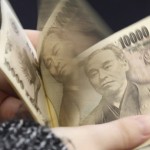Dollar Gains as Yuan Fallout Continues for Emerging Assets

The dollar strengthened as China’s shift to a more market-oriented exchange rate continued to reverberate through emerging economies, driving stocks and the ringgit lower. Oil fell, leading a gauge of commodities to a 13-year low.
The dollar was stronger against most peers by 12:41 p.m. in Hong Kong. The ringgit weakened 0.6 percent, dragging the Bloomberg JPMorgan Asia Dollar Index to a fifth straight loss, the longest such streak since February. The Hang Seng China Enterprises Index dropped 1.7 percent, while Malaysian equities retreated. U.S. oil sank 1.3 percent after the number of rigs increased for a fourth week.
China’s shock devaluation of its currency last week focused investors minds on frailties in other emerging markets, notably Malaysia and Turkey, which both are facing political crises. The yuan will probably move in both directions in the future, according to Ma Jun, chief economist at China’s central bank. A report on U.S. manufacturing Monday may offer clues on the timing of the Federal Reserve’s first interest-rate increase since 2006.
“The real lesson from the yuan last week was that the U.S. dollar is likely to appreciate against other Asian currencies,” Sam Tuck, a senior currency strategist at ANZ Bank New Zealand Ltd. in Auckland, said by instant message. “With a September Fed hike priced around a 50 percent probability, any developments that suggest a change in timing are being acted upon.”
The Bloomberg Dollar Spot Index increased 0.1 percent, climbing for a fourth day and close to erasing losses spurred by concern that China’s devaluation would undermine inflation and push back the Fed’s liftoff. The euro weakened 0.2 percent and the Swiss franc fell 0.2 percent.
Dwindling Reserves
The ringgit slid to 4.1062 per dollar, close to the weakest since Aug. 31, 1998, the day before the country implemented a fixed exchange rate to halt losses during the Asian financial crisis. The FTSE Bursa Malaysia KLCI Index dropped 1.5 percent toward its lowest since June 2012 and taking losses this month beyond 8.5 percent.
The currency slid 3.8 percent against the dollar last week as central bank Governor Zeti Akhtar Aziz said Thursday foreign-exchange reserves will need to be rebuilt after they fell below $100 billion for the first time since 2010. She ruled out introducing a currency peg or capital controls.
Thailand’s baht retreated 0.4 percent and the Philippines peso fell 0.3 percent with Indonesia’s rupiah. Poland’s zloty, Hungary’s forint also dropped at least 0.2 percent. Turkey’s lira was little changed after dropping to a record 2.8 per dollar last week as talks to form a coalition government failed.
The yuan was little changed at 6.3952 in onshore trade after the People’s Bank of China fixed the rate around which the currency can trade at 6.3969, just 0.01 percent from its level on Friday. The freely traded offshore currency was stronger for a third day.
Stability Preference
“The PBOC doesn’t want to see huge depreciation pressure,” said Eddie Cheung, a Hong Kong-based strategist at Standard Chartered Plc. “The narrowing gap between the yuan fixing and spot reflects a preference for stabilization.”
Chinese equities retreated in Hong Kong amid speculation that authorities may dial back support measures implemented to stem a $4 trillion rout in mainland markets. Insurers and banks were the biggest drags on the China Enterprises Gauge, with just four out of 40 stocks advancing. The Hang Seng Index dropped 1 percent.
The Shanghai Composite Index was little changed after jumping 5.9 percent last week. China will probably resume initial public offerings by year-end as a stock-market recovery gives policy makers confidence to pare back emergency support measures, according to analysts in a Bloomberg survey.
Commodities Weaker
The Bloomberg Commodity Index fell for a fifth straight day, slipping 0.4 percent toward its lowest level since 2002. Copper, aluminum and tin retreated at least 0.3 percent in London, while gold for immediate delivery was little changed at $1,116.89 an ounce.
West Texas Intermediate crude oil weakened to $41.97 a barrel, while Brent in London lost 1.2 percent to $48.60 a barrel. The number of rigs seeking oil rose by 2 to 672 for the sixth gain in seven weeks, Baker Hughes Inc. data show. Norway’s krone slipped 0.4 percent versus the dollar.
The Organization of Petroleum Exporting Countries may boost output to a record after Iran’s international sanctions are removed, according to the nation’s OPEC representative.
Source: Bloomberg – Dollar Gains as Yuan Fallout Continues for Emerging Assets





























